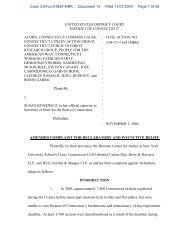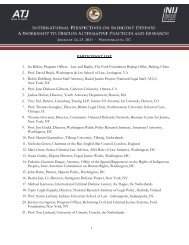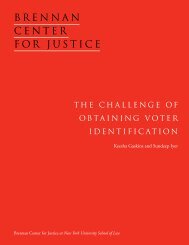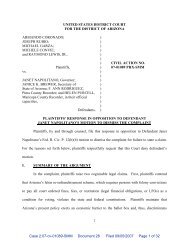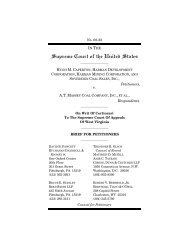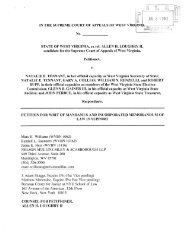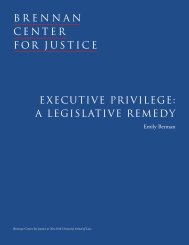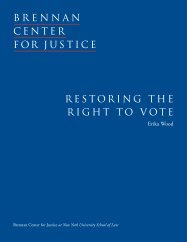THE NEW YORK STATE LEGISLATIVE PROCESS: AN ...
THE NEW YORK STATE LEGISLATIVE PROCESS: AN ...
THE NEW YORK STATE LEGISLATIVE PROCESS: AN ...
Create successful ePaper yourself
Turn your PDF publications into a flip-book with our unique Google optimized e-Paper software.
36 <strong>THE</strong> <strong>NEW</strong> <strong>YORK</strong> <strong>STATE</strong> <strong>LEGISLATIVE</strong> <strong>PROCESS</strong>: <strong>AN</strong> EVALUATION <strong>AN</strong>D BLUEPRINT FOR REFORM<br />
FIGURE 18<br />
FREQUENCY OF<br />
CONFERENCE COMMITTEES<br />
CONVENED<br />
IN 1999 <strong>LEGISLATIVE</strong> SESSION<br />
IN PROFESSIONAL LEGISLATURES<br />
ACCORDING TO RESPONSES<br />
TO NCSL QUERY<br />
State Frequency<br />
California 20-30<br />
House per biennium<br />
Illinois 42<br />
House to date<br />
Ohio 2<br />
Senate to date<br />
Pennsylvania 2<br />
Senate to date<br />
Wisconsin 1<br />
Senate to date<br />
of the twentieth century. Conference committees were briefly invoked to address<br />
individual bills in 1995, 1996, and 1997. 243 In 1999, efforts to use a conference<br />
committee to resolve conflicting budget bills broke down amidst fingerpointing<br />
and failed to become institutionalized. 244 In 2004, the Legislature assembled a<br />
conference committee that successfully reached agreement on several reforms to<br />
the budget process in Albany. 245 Generally, however, to pass a bill into law one<br />
chamber must move to substitute the other chamber’s version of the bill for its<br />
own, with the leaders of the two chambers working out any differences directly. 246<br />
As a result, unlike the many legislatures and the Congress, which use conference<br />
committees as a matter of course, New York does not have any established mechanism<br />
to prevent complete legislative failure if the Speaker and Majority Leader<br />
cannot resolve their differences directly in closed-door negotiations. The result, in<br />
too many cases, is simply legislative gridlock, even where the legislation at issue<br />
has garnered overwhelming popular and member support. In addition, New York<br />
does not obtain the benefits of a conference committee’s crafting, reviewing, and<br />
airing for public scrutiny the final version of a bill before it is voted into law.<br />
■ ENACTMENT RATES <strong>AN</strong>D <strong>THE</strong> INTRODUCTION<br />
OF BILLS<br />
New York State legislators introduce an extraordinarily large number of bills<br />
each year, few of which are passed or even considered by the full Legislature.<br />
From 1997 through 2001, 45,420 bills were introduced in the Assembly, and<br />
31,734 in the Senate. On average during that period, the Assembly and Senate<br />
passed only 2.29% and 7.91% of the bills introduced each year, respectively.<br />
Only 1.99% of the Assembly bills and 7.12% of the Senate bills introduced each<br />
year were signed into law during that period. 247 See Fig. 19.<br />
Although the numbers of bills introduced each year has generally risen across the<br />
country, more bills are introduced in the New York State Legislature than in any<br />
other state. This has been true in every year from 1997 through 2002 and, in all<br />
likelihood, before that period as well. In 2002, 16,892 bills were introduced in<br />
New York, the highest in the nation, followed by Illinois at 8,717 and<br />
Massachusetts at 7,924. 248<br />
New York’s rate of enactment – i.e., the percentage of bills introduced that<br />
are enacted into law – is one of the lowest in the nation. In 2002, New York’s<br />
enactment rate was 4.1%, higher than only two other states (New Jersey and<br />
North Carolina, both 2.7%), while the national average was 28%. 249 Among<br />
professional legislatures, only New Jersey’s enactment rate was lower than New<br />
York’s in 2002. 250 See Fig. 20. This is true despite the fact that New York State was<br />
sixth among states in the sheer number of bills signed into law in 2002 (693<br />
bills). 251 There is little relation – and none expected by most New York legislators –<br />
between the introduction of a bill and its passage.



